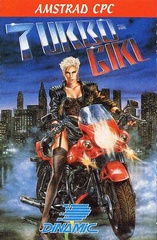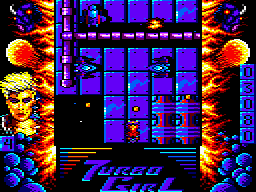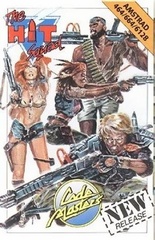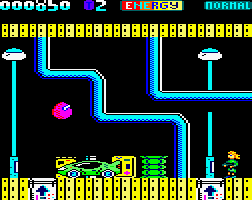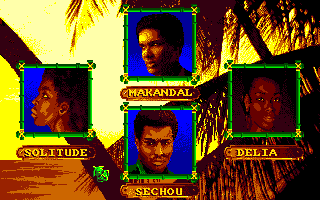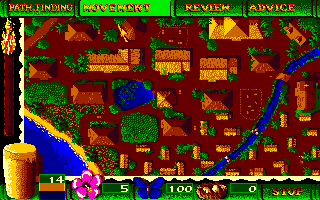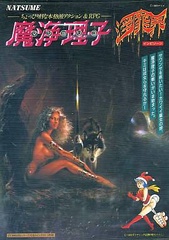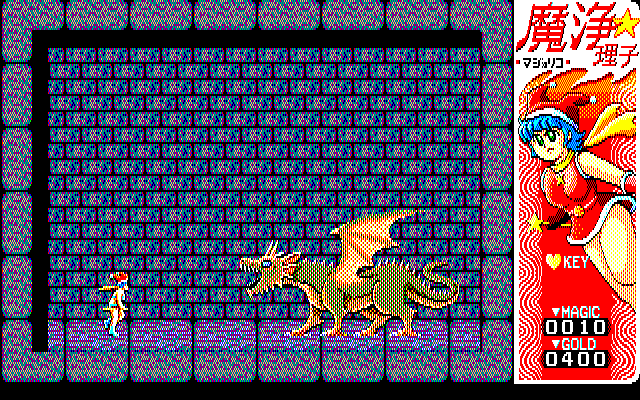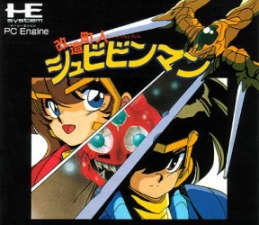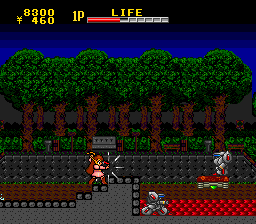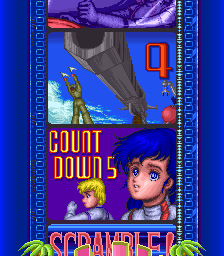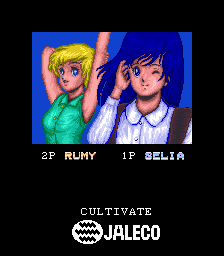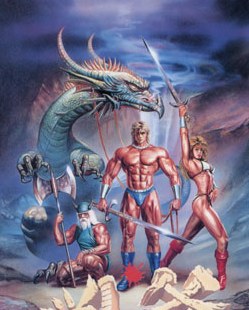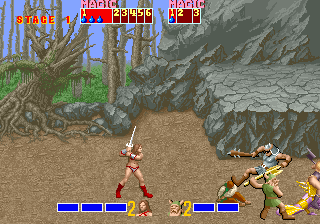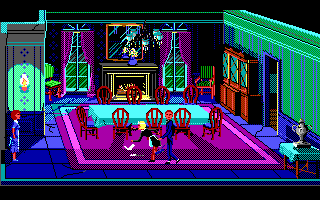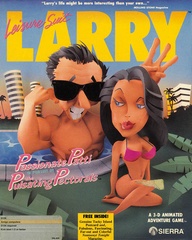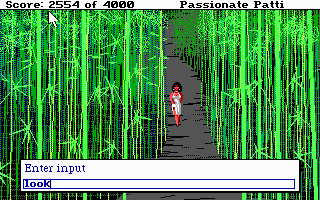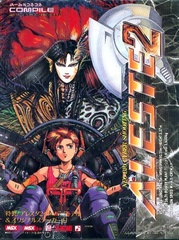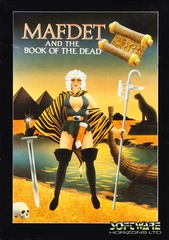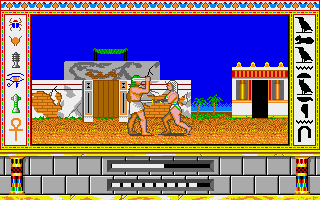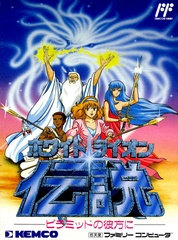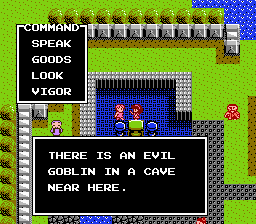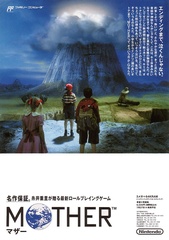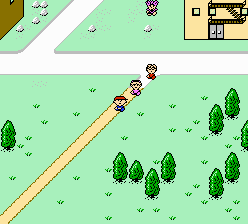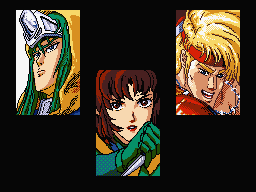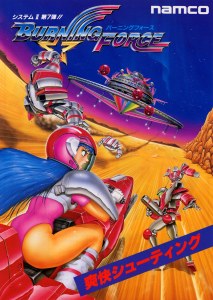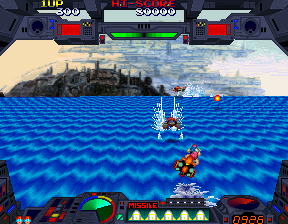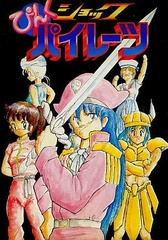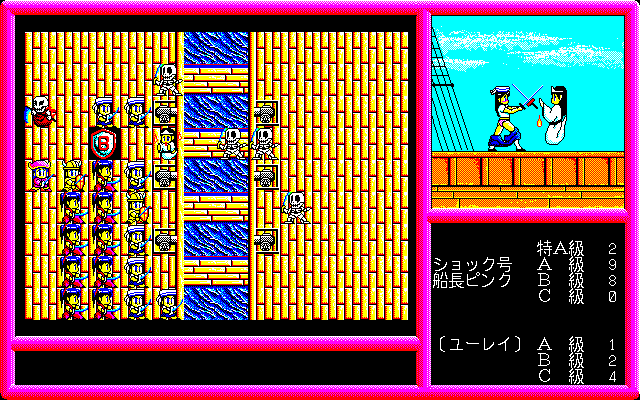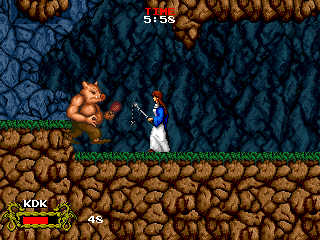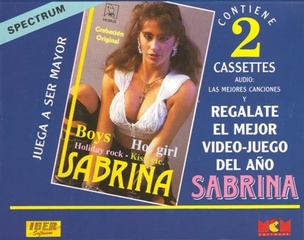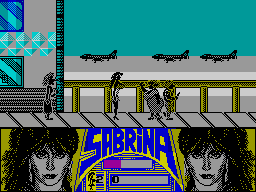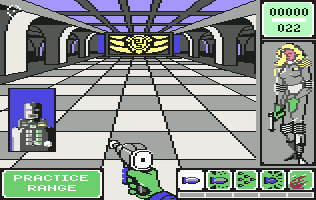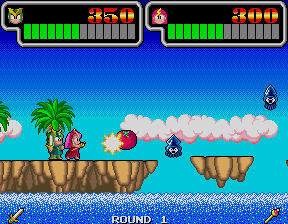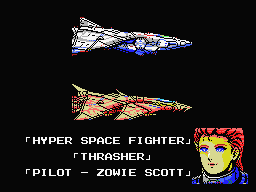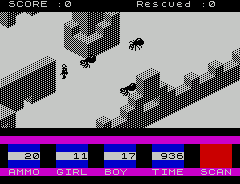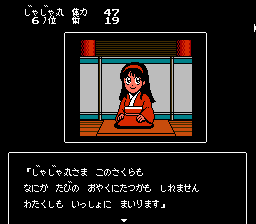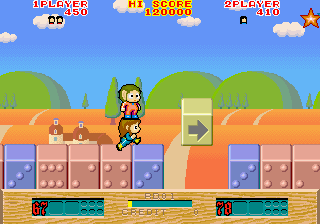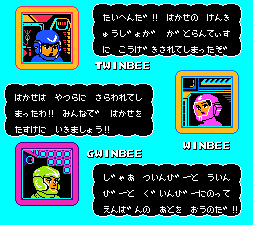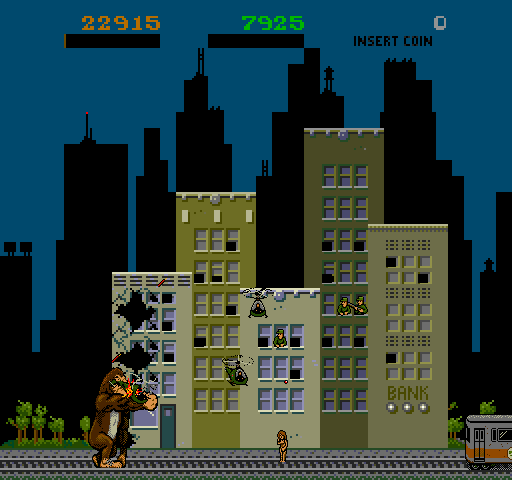Inventories: 1980s Video Game Heroines
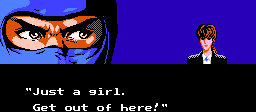
|
Next Page >>> |
Turbo Girl from Turbo Girl (1988)
It may be presented like a racing game on the cover, but Turbo Girl is actually a vertically scrolling shooter. The top-down perspective makes sure that the title character is hardly recognizable as such on screen, but the cover art looks a lot like Danish 80s "sex symbol" Brigitte Nielsen, complete with see-through top, even though another model actually posed for it.
Xena and Zara from The Hit Squad (1988)
Another game with a squad of four playable characters. This time, two of them are women and one is even cleary of color on the box, even though that doesn't translate at all into her sprite. The game itself is rather unremarkable, but ridiculously hard as usual for UK computer games.
Solitude and Delia from Freedom (1988)
Freedom is another French game (the Amiga version has been released in English) with a truly astonishing premise: As one of four African slaves on a tropical sugar plantation, the player is to lead a rebellion by rallying companions, sneaking past watchdogs and leading the slave warriors into direct physical struggles with their oppressors. The game is in a sim/action style similar to Sid Meier's Pirates. While the cover displays a muscular man breaking his iron shackles with sheer muscle power, two of the four playable insurgents are women.
Majoriko from Majoriko (1989)
Now here's a Japanese company you probably didn't know was making weird erotic games in the 1980s. Majoriko is a side-scrolling action RPG similar to many early Falcom games, except the shopkeepers are all ladies in lingerie and Majoriko gets gradually undressed as hear health goes down. If she's caught without any clothes, she is locked out of the Alice in Wonderland style world in the mirror. That is a shame, as it means she failed to rescue her friend Sawansa, who already got stripped down and captured by a tentacle monster in the intro. Perhaps the most troubling fact for many Westerners might be that the two girls are described as high school kids, although nudity in distressing situations seems to be as raunchy as the game gets.
Kyapiko / Sonya from Kaizō Chōjin Schbibinman (1989)
Schbibinman (or Shubibinman, depending on how you want to spell it) sort of began as the PC Engine equivalent of Mega Man. Much like Capcom's classic, the game stars a robot brother and sister team, Tasuke and Kyapiko. Except instead of sitting around and appearing in cutscenes like Roll, Kyapiko takes part in the action. The only game in the series to be released in English is the second game, where it was renamed Shockman, and Kyapiko was renamed Sonya.
Selia and Rumy from Plus Alpha (1989)
Female pilots in Japanese arcade shooting games are nothing special by 1989 (see Gradius, Aleste 2). The peculiar thing about Plus Alpha is that there are two pilots and both of them are women. And they're prominently featured, not only in the intro and ending but also with their portraits and a voice sample at the start of each stage.
Tyris Flare from Golden Axe (1989)
Golden Axe draws heavy inspiration from the Conan movies, while one of its three player characters, Tyris Flare, is clearly inspired by Red Sonja. One of the first female characters in a belt scrolling beat-em-up, Tyris would return in the Genesis sequel wearing a slightly more modest outfit, though later entries featured different warrior women. However, the Western developed HD rebootGolden Axe: Beast Rider featured Tyris as the sole player character, and while her design is radically different, her red and white bikini outfit is included as an unlockable.
Laura Bow from The Colonel's Bequest (1989) and The Dagger of Amon Ra (1991)
In The Colonel's Bequest, Roberta Williams revisted the murder mystery theme of her first game, Mystery House. But the evolution from a simple text adventure to a third person adventure required a player avatar, and so she created Laura Bow, based on the 1920s actress Clara Bow. While Clara was known for being a (relative to the era) bad girl, Laura is more of a Southern belle, who's studying at Tulane University before being drawn into a Clue-esque murder mansion. In the sequel, The Dagger of Amon Ra, she's broken down further gender barriers as a newspaper reporter in New York City, before getting tangled in another mystery, this time in a museum.
Passionate Patty from Leisure Suit Larry III (1989)
While the dating mishaps of Leisure Suit Larry laid at the forefront of Sierra's adventure game series, they dallied briefly by giving gamers a female viewpoint. This was Passionatte Patti, a jazz singer featured in the third game who was set up to be Larry's true love, and was willing to adventure through a jungle to find her lost beau. Patti was never quite Larry's equivalent - he was a hapless loser, she was a confident woman whose escapades somehow left her without clothes - but the different perspective was refreshing, and allowed for a whole other set of innuendos. The fifth Leisure Suit Larry game (really the fourth, it's a long story) also featured Patti, this time cast as an FBI agent. Later installments practically ignored her existence, since the developers couldn't figure out what to do with the character, and so Larry was again set free for more carousing.
Ellinor Wizn from Aleste 2 (1989) and sequels
Aleste is one of the many series of shooters from prolific 80s developer Compile. The closest the series has to a "star" is Ellinor Wizn, who was introduced in Aleste 2 for the MSX2 and was the daughter of the heroes from the original Aleste. The same character stars in GG Aleste for the Game Gear and MUSHA Aleste (simply known as MUSHA for the American release), which is subtitled "Fullmetal Fighter Ellinor" on the title screen. Although since these other games take place in separate continuities, they are not technically related from a storyline standpoint.
Mafdet from Mafdet and the Book of the Dead (1989)
Mafdet is supposedly the Egyptian "cat Goddess of Revenge", but if she's a goddess, then why is she so crappy in a swordfight? At least she got nine lives, so she can afford to suck to a degree, and is also able to transform into a cat to jump over pits. Her design is the typical big-chested, barely clad approach to heroism, although she does sport some wicked white locks (who look more like a chainmail hood in the game).
Maria from White Lion Densetsu / Legend of the Ghost Lion (1989)
The Famicom was flooded with Dragon Quest clones, and Legend of the Ghost Lion from Kemco was one of the few to be localized for the NES. The game stars Maria, a girl wose parents disappeared when searching for a white lion that had attacked their village. Although her in-game depiction matches the Japanese artwork, her American representation looks like something out of a nightmarish 80s workout video.
Ana / Anna from Mother (1989)
Mother may be one of the most unique 8-bit RPGs around, but for its party of characters it falls into the old trap of the group of kids with a single token girl in their midst. For Mother this is Ana, the daughter of the pastor from the town Snowman. Her mother has been abducted, and so she joins the hero Ninten to find about her whereabouts. She's physically weak, but she has very strong PSI powers.
Ruika from Undeadline (1989)
This run-and-gun by the creators of Hydlide features three playable characters with different stats, including the ninja Ruika. She is the fast and agile character of the three, but in good old female video game ninja tradition (see Ninja Princess), she is eager to sacrifice camouflage if it means that she can show off her perfect legs.
Hiromi Tengenji from Burning Force (1989)
Namco's Space Harrier-type game features a young woman by the name of Hiromi Tengenji, a student trying out for her pilot's license. However, rather than floating around the screen like the main character from Sega's game, she rides a transforming jetski. She appears alongside Baraduke heroine Toby Masuyo (without her helmet) in Namco vs. Capcom.
Pink and her crew from Pink Shock Pirates (1989)
Not many will have heard of Pink Shock Pirates, as it was a Japanese RPG series exclusive to the NEC PC-98. The game stars a plucky pirate called Pink, who sets out to assemble her crew and rule the seven seas. The first game is very simulation heavy, with large battles involving dozens of generic hired sailors. Pink Shock Pirate II in 1990 puts on a more personal focus, where Pink becomes the leader of an all-women team of five. The third game more or less abandons the pirate theme despite keeping the title, and stars the warrior Sara (who was previously a party member), whose band of adventurers also includes a few men. As so many Japanese computer games, Pink Shock Pirates has some vaguely erotic content, but it never goes beyond slapsticky stuff like the female fighters dropping their pants when hit (only seen from behind).
The Priest from Cadash (1989)
Taito's Cadash was one of the arcade games that, like Wonder Boy in Monster Land and Legend of Valkyrie, melded action with RPG elements. There are four classes, with the Priest being the lone female character, even though it's a little hard to tell at first. It's also a little odd that they refer to her as "priest" rather than "priestess". In fact, the English arcade translation seems unsure of the character's gender - the select screen refers to the other characters as "he" but dodges the pronoun on the Priest's description, and the King refers to the player as a man regardless of which character they've chosen.
Sabrina from Sabrina (1989)
Sabrina is another celebrity lookalike, this time for popular (at least in the 1980s) Italian singer Sabrina Salerno, and the screenshot should make it painfully obvious which aspect of the star's appeal the developers fixated on. It seems like this appearance was actually officially endorsed - at least there were advertisements printed that showed Salerno's face along with namedropping her hit song Boys - which is even more astonishing as the ending shows the protagonist flashing her breasts during a concert.
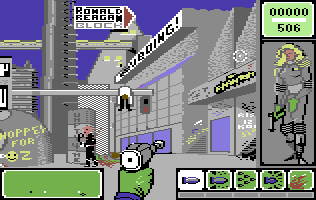
Sinclair from Horror City (1989)
If the heroine in this uninspired crosshair shooter for the C64 looks a bit reminiscent of Judge Anderson from the Judge Dredd universe, it's only because Horror City was originally meant to be a licensed game with the title Judge Death, where the Psi-judge would have had to take out the four Dark Judges, which are now replaced by more silly-looking monsters. You only ever get to steer sinclairs gun hand, but to make sure you never forget that this game is starring a woman, Novotrade included a side bar with a full body portrait to fill the right side of the screen at all times.
Wonder Boy III: Monster Lair (Arcade)

Devil World (Arcade)
Salamander (MSX)
Ant Attack (ZX Spectrum)
Jajamaru Ninpō Chō (Famicom)
Also-rans and borderline cases
There are a few more examples that either skim the edges of our requirements or are just more player 2 sprites with nothing much in particular to say about them. For the latter category, there are Stella from Stella from Alex Kidd: Lost Stars (1986) and Princess Purapril from Wonder Boy III: Monster Lair (1988), who accompany the respective main hero in multiplayer. Zowie Scott in the MSX Salamander remix is even less than that, as her face is shown only briefly in the intro, before she pilots the red ship for the remidner of the game, just like Tiat in Darius. Moero! Twinbee (1986) also features a female pilot for the Winbee, but it's not established whether she is supposed to be Pastel, which became a more fleshed-out character in several sequels during the 1990s. Knightmare II: The Maze of Galious (1987) features Aphrodite alongside Knightmare series hero Popolon, but she is just a pink palette swap of him in his armor.
Princess Sakura, a damsel in distress in Ninja Jajamaru-kun (1985) becomes Jajamaru's sidekick and party member in the RPG Jajamaru Ninpō Chō (1989). She is also selectable as an alternate character (with identical abilities) in Ninja Jajamaru: Ginga Daisakusen (1991). The two versions of the top-down arcade action game Dark Adventure / Devil World differ quite a lot, including the number of playable characters, but both feature fighting lady Labryna for the second player, who can use all the same weapons as her male companion(s).
For the Day Advertisement
The arcade shooters Solar Fox (1982) and Wyvern F-0 (1985) feature women prominently on the arcade flyers, but given their age, it's understandable that there is no representation of them in the actual games. There is also a preserved flyer from 1982 for an arcade title called Mrs. Dynamite starring a female pyromaniac, but as far as anyone can tell the game was never released. Definitely unreleased is the first episode in Mirinae Software's For the Day series, whose advertisement in 1989 showed a woman as the hero, but the released sequel replaces her with a male pilot.
The protagonist in Faria (1989) has the appearance of a woman at the beginning of the game (and on the Japanese cover), but about halfway through it is revealed that he is really a prince who was cursed by a wizard. Another transformation occurs with Lizzy in Rampage (1986), who is a giant reptile during the game and only turns back into a human woman when she is defeated.
The British 1983 proto survival horror game Ant Attack offers the choice between a girl and a boy as the player character, who then has to rescue the respective other, but they're both kept name- and featureless.
|
Next Page >>> |
